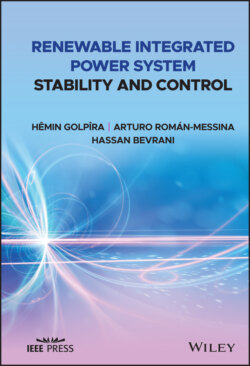Читать книгу Renewable Integrated Power System Stability and Control - Hassan Bevrani - Страница 24
1.4.2 Parameters Estimation
ОглавлениеFor estimation of all required parameters, the recorded data from the installed PMUs can be used. As shown in Figure 1.2, firstly, a de‐noising methodology, mostly based on rolling averaging windows, can be employed to prepare the received PMU data for further processing. Afterwards, some data‐driven‐based algorithms are used to estimate the most important parameters (e.g., system inertia, droop characteristic, and damping factor) required for building low order power system models such as frequency response model [32] and oscillation model [3]. In real‐time operation, an accurate and fast estimation of parameters is required. The estimated parameters can be used in the auto‐tuning algorithm of the controllers.
In a modern power system, in addition to scheduling parameters, several algorithms need to be developed for online estimating of other important system parameters such as synchronizing coefficient between various areas, rate of change of frequency/voltage (ROCOF/ROCOV), frequency/voltage nadir, and time occurrence of frequency/voltage nadir. The estimations must be fast enough and should cover the issues related to the existing time delay. These data‐driven‐based estimation algorithms can be analytically developed based on the concept of swing equation, base‐case systems, regression, and curve fitting. These measurement‐based dynamics identification and system modeling can be used for adaptive online parameters tuning of the targeted controllers. The increasing size and diversification of demand/power sources magnify the importance of this issue in the modern power grids. The estimation approaches may be applicable for both on‐line and off‐line methods. However, for on‐line applications, shorter data windows must be used.
PMU data‐based power‐load imbalance estimation is a key estimation to successfully handle the emergency control strategies, e.g. load shedding, and protection plans. In case of detecting a contingency or an emergency condition, following comparing of frequency, voltage, and their rate of changes with the specified threshold values, an estimation algorithm must estimate the size of disturbance to use in the available emergency control systems and special protection schemes. This online estimation is an important issue to realize a successful load‐shedding scheme with minimum amount of shed load.
Conventionally, for the estimation of the size of load‐power mismatch, the swing equation is used. The estimated imbalance based on this method may far from real power mismatch as it relies on three worst assumptions: (i) there is no additional active power variation except for that of disturbance, (ii) there is a negligible reactive‐power imbalance in response to sudden active power imbalance, and (iii) the inertia constant assumed to be known. This under/over‐estimation causes inaccurate calculation of total amount of load to be shed.
In [117], for estimating the size of disturbance, some appropriate base‐case features are selected from a set of pre‐defined base cases. Moreover, an efficient yet simple logic is defined to select appropriate base‐case for the received data. This approach benefits from the use of PMU data to precise calculation of the required amount of load to be shed, in one‐step and in a short time in comparison with the actual time. The proposed scheme relies on fast, yet iterative, estimation of frequency nadir, and time of minimum frequency occurrence. Accordingly, the inertia constant as well as the size of power mismatch are estimated which, in turn, compares with the maximum size of imbalance, satisfying the pre‐specified thresholds, to determine the amount of shed load.
